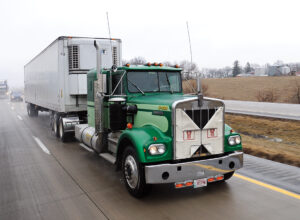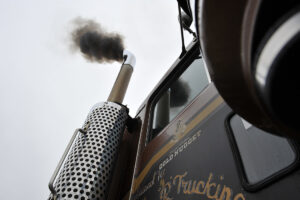Now that winter has arrived, we receive occasional calls about whether or not a winter front should be installed. You sometimes see them on trucks when driving down the highway. It makes people think that they are not doing all they can for their truck. This could not be further from the truth. Ignoring the advice of anyone who recommends one to you would be beneficial. Winter fronts are only necessary in rare cases and are not needed for modern engines. Detroit Diesel specifically states that a winter front should only be used when the outside air temperature is less than -22F and if the engine is having a hard time maintaining 175F of coolant temperature.
For our northern friends, this doesn’t sound that uncommon, but when I see winter fronts in warmer states like Pennsylvania, I cringe. While they may help keep heat in the radiator, they also keep it in the charge air cooler, as well. Controlling intake manifold temperature is critical to performance and fuel mileage. To describe how excessive intake temperatures can be harmful, allow me to list a few downsides: excessive temperatures can keep the engine fan on which reduces power and fuel mileage; excessive temperatures can increase NOx emissions that increase EGR or DEF consumption; excessive intake temperatures mean the exhaust temperature will also be higher; and sometimes excessive intake temperatures can give false readings to sensors which could lead to check engine lights and less run time.
While many of the winter fronts I see do not totally block the grill, they are still restrictive, and can cause performance issues. Even if you don’t experience check engine lights, your engine is suffering. It is recommended that if you must use a winter front, that it must be at least 25% open. If your truck is having some difficulty maintaining a good operating temperature during the winter, then you are probably having an issue with your cooling system.
Have you been experiencing an issue with your DDEC 3 or 4 Series 60 where, after a long period of no throttle input, your engine will stutter and blow smoke after you begin to accelerate again? We get this call all the time, and, thankfully, the fix is really simple. I hear people tell me all the time that they have replaced injectors, sensors, wiring harnesses, and even cylinder heads trying to fix this issue! But the issue is in the ECM calibration. For some reason, the calibration calls for an extremely retarded beginning of injection. In some cases, the ECM will not begin to inject fuel until 10 degrees after top dead center. At this point in the cycle, there is no hope for the engine to have a “successful” combustion cycle.
When this happens, you can clearly see and feel that something is not right when you feel the engine shudder and see smoke pouring from the exhaust. We have fixed many engines with this issue, and the owners are always very skeptical that this will be the fix. And, after spending years chasing this problem, I would be skeptical too, that it is just a calibration issue. But once we adjust the calibration, that prevents the ECM from requesting such retarded timing, and you will never have this issue again. You can go to any one of our remote tuning locations or you can come to our facility here in Saxonburg, PA, and we will take care of it for you once and for all.
I would like to thank and credit Leroy Pershing here at Pittsburgh Power for writing this month’s article. If you have any comments or questions, feel free to visit our location in Saxonburg, PA, call us at (724) 360-4080, visit our website (www.pittsburghpower.com), or send us an email to information@pittsburghpower.com. You can also reach us through our various social media channels. We look forward to not only hearing from you, but serving your truck’s ongoing needs, as well. Like I have said many times before, we are here to help you!


